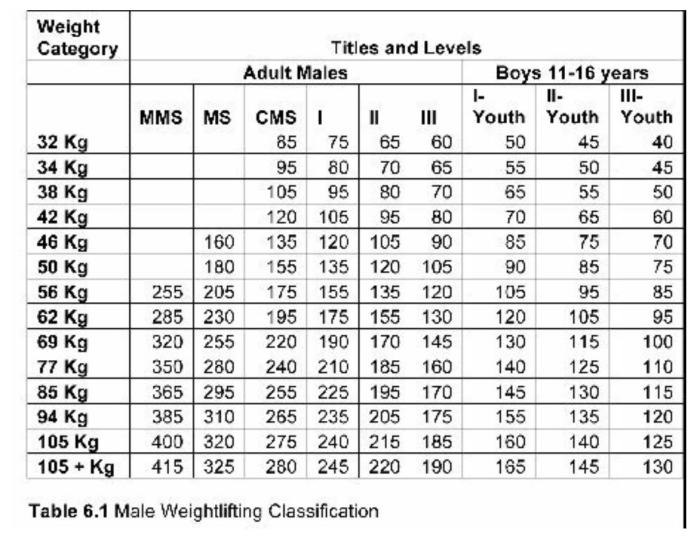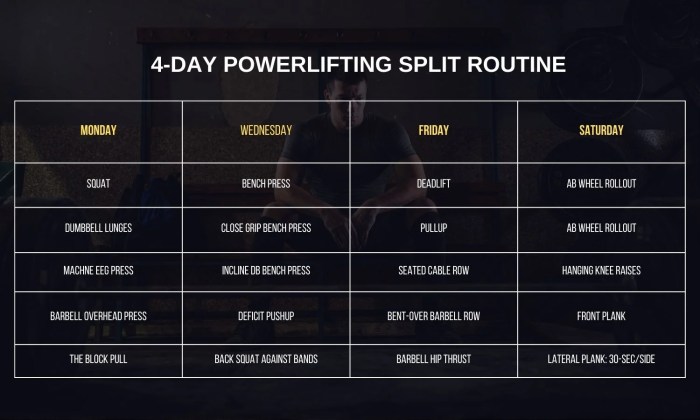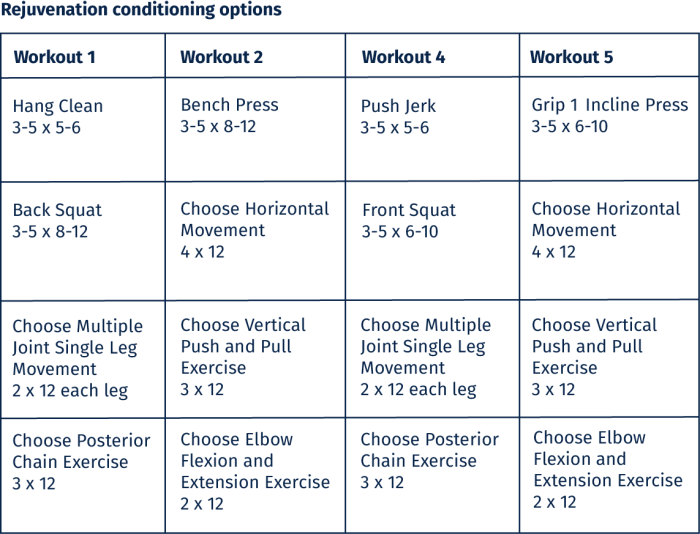Lifting program for strength – Welcome to the ultimate guide to crafting a lifting program that will transform your body and unleash your inner strength. Embark on this journey as we delve into the secrets of building muscle, maximizing power, and achieving your fitness goals.
Get ready to sweat, push your limits, and witness the incredible results that await you!
This comprehensive program will equip you with everything you need to know, from exercise selection and proper form to nutrition and recovery strategies. Whether you’re a seasoned lifter or just starting your fitness journey, this guide will empower you to unlock your full potential and achieve the physique you’ve always dreamed of.
Common Mistakes
Beginners in strength training often make mistakes that can hinder their progress or even lead to injury. Here are some common mistakes and tips on how to avoid them:
Lifting too heavy:It’s important to start with a weight that is challenging but not too heavy. Lifting too heavy can put unnecessary stress on your joints and muscles, increasing the risk of injury.
Using improper form
Proper form is essential for maximizing results and preventing injury. Using improper form can reduce the effectiveness of the exercise and put unnecessary stress on your body.
- Not warming up:Warming up before lifting weights is crucial for preparing your body for the workout and reducing the risk of injury. A proper warm-up should include light cardio and dynamic stretching.
- Not cooling down:Cooling down after lifting weights helps your body recover and reduces muscle soreness. A proper cool-down should include light cardio and static stretching.
- Overtraining:Overtraining can lead to burnout, injury, and decreased performance. It’s important to listen to your body and rest when needed.
- Not getting enough protein:Protein is essential for building and repairing muscle tissue. Make sure to consume enough protein throughout the day, especially after workouts.
- Not sleeping enough:Sleep is essential for recovery and muscle growth. Aim for 7-8 hours of sleep each night.
Sample Workout Plan
Beginners should start with a well-structured workout plan that focuses on compound exercises, proper form, and progressive overload. Here’s a sample plan to get you started.
Exercises, Lifting program for strength
- Barbell Squats: 3 sets of 8-12 repetitions
- Bench Press: 3 sets of 8-12 repetitions
- Overhead Press: 3 sets of 8-12 repetitions
- Barbell Rows: 3 sets of 8-12 repetitions
- Dumbbell Lunges: 3 sets of 10-15 repetitions per leg
Choose weights that challenge you while maintaining good form. Rest for 60-90 seconds between sets.
Frequency
Perform this workout plan 2-3 times per week, allowing for at least 48 hours of rest between workouts for each muscle group.
Progression
As you get stronger, gradually increase the weight or resistance you’re using. You can also add more sets or repetitions to your workouts over time.
Advanced Techniques

As you progress in your strength training journey, you may want to explore advanced techniques to challenge yourself and break through plateaus. These techniques can intensify your workouts, but they also come with increased risks, so it’s crucial to use them with caution and under the guidance of an experienced coach or trainer.
Drop Sets
Drop sets involve performing multiple sets of an exercise without rest, gradually reducing the weight after each set. This technique helps to exhaust your muscles and push them to failure, stimulating muscle growth. However, it’s essential to maintain proper form and avoid excessive weight drops, as this can increase the risk of injury.
Forced Reps
Forced reps involve having a spotter assist you with the final few repetitions of a set, allowing you to push past your momentary failure point. This technique can help to increase muscle fiber activation and promote hypertrophy. However, it should be used sparingly and with proper supervision, as it can put excessive stress on your joints and muscles.
Supersets
Supersets involve performing two or more exercises back-to-back with little or no rest between them. This technique helps to save time and increase training intensity, but it can also be very demanding on your cardiovascular system. It’s important to choose exercises that target different muscle groups to avoid overtraining and injury.
| Technique | Purpose | Benefits | Risks |
|---|---|---|---|
| Drop Sets | Exhaust muscles and promote growth | Increased muscle fiber activation | Increased risk of injury if weight is dropped too quickly |
| Forced Reps | Push past failure point and promote hypertrophy | Increased muscle fiber recruitment | Increased stress on joints and muscles |
| Supersets | Save time and increase intensity | Improved cardiovascular endurance | Increased risk of overtraining and injury |
Advanced techniques can be valuable tools for experienced lifters looking to challenge themselves and break through plateaus. However, it’s crucial to use them with caution and under the guidance of a qualified professional to minimize the risks and maximize the benefits.
Importance of Proper Form and Recovery
When using advanced techniques, it’s imperative to maintain proper form throughout your exercises to prevent injury. It’s also crucial to allow for adequate rest and recovery between workouts to give your body time to repair and rebuild. Listen to your body and take rest days when needed to avoid burnout and overtraining.
Tracking Progress
Tracking your progress is crucial in strength training to monitor your gains, identify areas for improvement, and make necessary adjustments to your program. By keeping a detailed log of your training sessions, you can gain valuable insights into your progress and stay motivated.
Measuring Strength Gains
There are several methods to measure your strength gains:
- 1-Rep Max (1RM):The maximum weight you can lift for a single repetition.
- Working Weight:The weight you use for your regular sets and repetitions.
- Bodyweight Exercises:Measuring progress by tracking the number of repetitions or sets you can complete with bodyweight exercises.
Logging Training Data
To track your progress effectively, it’s essential to maintain a training log that includes the following data:
- Date:The date of the workout.
- Exercise:The specific exercise performed.
- Sets:The number of sets completed.
- Reps:The number of repetitions performed in each set.
- Weight:The weight used for each set.
- Other Metrics:Any other relevant metrics, such as rest time, tempo, or perceived exertion.
Visualizing Progress
Graphs and charts can be valuable tools for visualizing your progress over time. By plotting your data points, you can easily identify trends, such as increases in 1RM or working weight. This visual representation makes it easier to assess your progress and make informed decisions about your training.
Interpreting Progress Data
Once you have tracked your progress for some time, you can begin to interpret the data and make adjustments to your training program as needed:
- Consistent Gains:If you are consistently making progress, continue with your current program and gradually increase the weight or resistance.
- Plateaus:If you reach a plateau where your progress stalls, consider changing your training variables, such as the weight, sets, reps, or exercise selection.
- Setbacks:If you experience a setback, such as an injury or illness, adjust your program accordingly and focus on recovery.
Safety Considerations

Prioritizing safety is paramount in strength training to prevent injuries and maintain optimal form. Adhering to proper techniques and precautions is essential for a successful and injury-free training experience.
To ensure safety, it is crucial to:
- Warm up thoroughlybefore each workout to prepare your muscles and joints for the upcoming exertion.
- Use proper formduring all exercises to minimize stress on your body and maximize effectiveness.
- Lift weights that are appropriatefor your fitness level and gradually increase the weight as you progress.
- Listen to your bodyand rest when necessary to avoid overexertion and injury.
- Use a spotterwhen attempting heavy lifts for added safety.
- Maintain a clean and organized gym environmentto prevent accidents.
Additional Resources

To further your strength training journey, here are some valuable resources that provide expert guidance, practical advice, and support.
These resources cover a wide range of topics, from exercise demonstrations and nutrition tips to injury prevention strategies. By accessing these reliable sources, you can enhance your knowledge and optimize your training regimen.
Exercise Demonstrations
Watching demonstrations of proper exercise form is crucial for effective and safe strength training. Here are some reputable sources where you can find high-quality exercise videos:
Nutrition Advice
Proper nutrition is essential for supporting your strength training goals. These resources offer evidence-based advice on how to fuel your body for optimal performance:
Injury Prevention
Preventing injuries is paramount in strength training. These resources provide valuable tips and strategies to help you stay safe and healthy:
“Strength training is not just about lifting heavy weights. It’s about improving your overall health, mobility, and longevity.”- National Strength and Conditioning Association (NSCA)
Additional Resources
Here are some additional books, articles, and websites that can provide further insights into strength training:
- Starting Strengthby Mark Rippetoe
- The Strength Training Bibleby Joe Weider
- Science and Practice of Strength Trainingby Vladimir Zatsiorsky and William Kraemer
- Stronger By Science
- T-Nation
Outcome Summary

Remember, building strength is not just about lifting weights; it’s about embracing a holistic approach that encompasses proper nutrition, adequate rest, and a relentless mindset. By following the principles Artikeld in this guide, you will not only transform your body but also cultivate an unwavering determination that will carry you through any challenge life throws your way.
Embrace the power of strength training, and let it be the catalyst for a healthier, more fulfilling, and empowered life.
Essential Questionnaire: Lifting Program For Strength
How often should I lift weights to build strength?
For optimal strength gains, aim for 2-3 strength training sessions per week, focusing on compound exercises that work multiple muscle groups simultaneously.
What is progressive overload and why is it important?
Progressive overload is gradually increasing the weight, sets, reps, or exercise difficulty over time. It is crucial for continuous strength development, as it forces your muscles to adapt and grow.
How much protein should I consume for muscle growth?
Aim for a daily protein intake of 1.6-2.2 grams per kilogram of body weight (0.7-1 gram per pound). This will provide your muscles with the essential building blocks they need to repair and grow.
Is it okay to feel sore after a strength training workout?
Yes, muscle soreness (DOMS) is a common response to strength training. It typically peaks 24-48 hours after your workout and gradually subsides within a few days.
Leave a Reply